Spatiotemporal Linkages between Administrative Division Adjustment and Urban Form: Political Drivers of the Urban Polycentric Structure
Abstract
1. Introduction
2. Literature Review
2.1. ADA and Its Development in China
2.2. The Driving Forces of POLY
3. Methodology and Data
3.1. Methodological Framework
3.2. Study Area
3.3. Data Sources
3.4. Research Methods
3.4.1. Assessment of Urban Polycentricity
3.4.2. Moran’s I Index
3.4.3. Ordinary Least Squares Model
3.4.4. Geographically and Temporally Weighted Regression Model
3.5. Variable Measurement
4. Results
4.1. Characteristics of ADA and POLY
4.2. Spatiotemporal Pattern of POLY Agglomeration
4.3. Impacts of ADA and Socioeconomic Factors on POLY
4.4. Driving Factors of POLY between Cities with and without ADA
5. Discussion
5.1. Policy Related to ADA and Urbanization
5.2. The Relationship between ADA and POLY
5.3. The Spatiotemporal Pattern of ADA and POLY
5.4. Policy Implications
5.5. Contribution and Limitation
6. Conclusions
Author Contributions
Funding
Data Availability Statement
Conflicts of Interest
References
- Wang, J.; Zhang, X. Land-Based Urbanization in China: Mismatched Land Development in the Post-Financial Crisis Era. Habitat Int. 2022, 125, 102598. [Google Scholar] [CrossRef]
- Ren, Q.; Liu, D.; Liu, Y. Spatio-Temporal Variation of Ecosystem Services and the Response to Urbanization: Evidence Based on Shandong Province of China. Ecol. Indic. 2023, 151, 110333. [Google Scholar] [CrossRef]
- Tian, L.; Yan, Y.; Lin, G.C.S.; Wu, Y.; Shao, L. Breaking the Land Monopoly: Can Collective Land Reform Alleviate the Housing Shortage in China’s Mega-Cities? Cities 2020, 106, 102878. [Google Scholar] [CrossRef]
- Sun, C.; Lu, J. The Relative Roles of Socioeconomic Factors and Governance Policies in Urban Traffic Congestion: A Global Perspective. Land 2022, 11, 1616. [Google Scholar] [CrossRef]
- Zhang, X.; Han, L.; Wei, H.; Tan, X.; Zhou, W.; Li, W.; Qian, Y. Linking Urbanization and Air Quality Together: A Review and a Perspective on the Future Sustainable Urban Development. J. Clean. Prod. 2022, 346, 130988. [Google Scholar] [CrossRef]
- Wu, Y.; Zong, T.; Shuai, C.; Liao, S.; Jiao, L.; Shen, L. Does Resource Environment Carrying Capacity Have a Coercive Effect on Urbanization Quality? Evidence from the Yangtze River Economic Belt, China. J. Clean. Prod. 2022, 365, 132612. [Google Scholar] [CrossRef]
- Chen, M.; Liu, W.; Lu, D.; Chen, H.; Ye, C. Progress of China’s New-Type Urbanization Construction since 2014: A Preliminary Assessment. Cities 2018, 78, 180–193. [Google Scholar] [CrossRef]
- Zhang, Y.; Wang, L.; Tang, Z.; Zhang, K.; Wang, T. Spatial Effects of Urban Expansion on Air Pollution and Eco-Efficiency: Evidence from Multisource Remote Sensing and Statistical Data in China. J. Clean. Prod. 2022, 367, 132973. [Google Scholar] [CrossRef]
- Ding, C.; Zhao, X. Land Market, Land Development and Urban Spatial Structure in Beijing. Land Use Policy 2014, 40, 83–90. [Google Scholar] [CrossRef]
- Hu, L.; Sun, T.; Wang, L. Evolving Urban Spatial Structure and Commuting Patterns: A Case Study of Beijing, China. Transp. Res. Part D Transp. Environ. 2018, 59, 11–22. [Google Scholar] [CrossRef]
- Zhang, L.; Shu, X.; Luo, J. The Formation of a Polycentric City in Transitional China in a Three-Level Analysis Framework: The Case Study of Hangzhou. Land 2022, 11, 2054. [Google Scholar] [CrossRef]
- Wang, T.; Yue, W.; Ye, X.; Liu, Y.; Lu, D. Re-Evaluating Polycentric Urban Structure: A Functional Linkage Perspective. Cities 2020, 101, 102672. [Google Scholar] [CrossRef]
- Hu, R. New Directions in Chinese Metropolitan Planning; Taylor & Francis: Abingdon, UK, 2023. [Google Scholar]
- Sun, T.; Lv, Y. Employment Centers and Polycentric Spatial Development in Chinese Cities: A Multi-Scale Analysis. Cities 2020, 99, 102617. [Google Scholar] [CrossRef]
- Zhang, T.; Sun, B.; Li, W. The Economic Performance of Urban Structure: From the Perspective of Polycentricity and Monocentricity. Cities 2017, 68, 18–24. [Google Scholar] [CrossRef]
- Chen, M.; Ye, C.; Lu, D.; Sui, Y.; Guo, S. Cognition and Construction of the Theoretical Connotations of New Urbanization with Chinese Characteristics. J. Geogr. Sci. 2019, 29, 1681–1698. [Google Scholar] [CrossRef]
- Zeng, C.; Song, Y.; He, Q.; Liu, Y. Urban–Rural Income Change: Influences of Landscape Pattern and Administrative Spatial Spillover Effect. Appl. Geogr. 2018, 97, 248–262. [Google Scholar] [CrossRef]
- Yu, H.; Deng, Y.; Xu, S. Evolutionary Pattern and Effect of Administrative Division Adjustment During Urbanization of China: Empirical Analysis on Multiple Scales. Chin. Geogr. Sci. 2018, 28, 758–772. [Google Scholar] [CrossRef]
- Wu, K.Y.; Zhang, H. Land Use Dynamics, Built-up Land Expansion Patterns, and Driving Forces Analysis of the Fast-Growing Hangzhou Metropolitan Area, Eastern China (1978–2008). Appl. Geogr. 2012, 34, 137–145. [Google Scholar] [CrossRef]
- Feng, R.; Wang, F.; Wang, K.; Xu, S. Quantifying Influences of Anthropogenic-Natural Factors on Ecological Land Evolution in Mega-Urban Agglomeration: A Case Study of Guangdong-Hong Kong-Macao Greater Bay Area. J. Clean. Prod. 2021, 283, 125304. [Google Scholar] [CrossRef]
- Chien, S.-S. New Local State Power through Administrative Restructuring—A Case Study of Post-Mao China County-Level Urban Entrepreneurialism in Kunshan. Geoforum 2013, 46, 103–112. [Google Scholar] [CrossRef]
- Wang, J.; Yeh, A.G.O. Administrative Restructuring and Urban Development in China: Effects of Urban Administrative Level Upgrading. Urban Stud. 2020, 57, 1201–1223. [Google Scholar] [CrossRef]
- Li, Y.; Derudder, B. Dynamics in the Polycentric Development of Chinese Cities, 2001–2016. Urban Geogr. 2022, 43, 272–292. [Google Scholar] [CrossRef]
- Wu, F.; Phelps, N.A. (Post)Suburban Development and State Entrepreneurialism in Beijing’s Outer Suburbs. Environ. Plan. A Econ. Sp. 2011, 43, 410–430. [Google Scholar] [CrossRef]
- Chorianopoulos, I. State Spatial Restructuring in Greece: Forced Rescaling, Unresponsive Localities. Eur. Urban Reg. Stud. 2012, 19, 331–348. [Google Scholar] [CrossRef]
- Li, H.; Wei, Y.D.; Liao, F.H.; Huang, Z. Administrative Hierarchy and Urban Land Expansion in Transitional China. Appl. Geogr. 2015, 56, 177–186. [Google Scholar] [CrossRef]
- Feng, R.; Wang, K. Spatiotemporal Effects of Administrative Division Adjustment on Urban Expansion in China. Land Use Policy 2021, 101, 105143. [Google Scholar] [CrossRef]
- Zeng, C.; Zhang, A.; Liu, L.; Liu, Y. Administrative Restructuring and Land-Use Intensity—A Spatial Explicit Perspective. Land Use Policy 2017, 67, 190–199. [Google Scholar] [CrossRef]
- Chao, F.; You, C.; Jin, W. Optimizing Urban Stock Space through District Boundary Reorganization: Hangzhou’s Administrative Adjustment. Land 2023, 12, 959. [Google Scholar] [CrossRef]
- Liu, Y.; Yin, G.; Ma, L.J.C. Local State and Administrative Urbanization in Post-Reform China: A Case Study of Hebi City, Henan Province. Cities 2012, 29, 107–117. [Google Scholar] [CrossRef]
- Zhu, C.H.; Xie, H.M.; Zhou, W.X.; Zhang, S.W. Impact of Administrative Division Adjustment on Location and Accessibility of Heifei, China. Appl. Mech. Mater. 2012, 253–255, 271–277. [Google Scholar] [CrossRef]
- Miller, H.J. Tobler’s First Law and Spatial Analysis. Ann. Assoc. Am. Geogr. 2004, 94, 284–289. [Google Scholar] [CrossRef]
- He, S.; Yu, S.; Li, G.; Zhang, J. Exploring the Influence of Urban Form on Land-Use Efficiency from a Spatiotemporal Heterogeneity Perspective: Evidence from 336 Chinese Cities. Land Use Policy 2020, 95, 104576. [Google Scholar] [CrossRef]
- Zhu, J.; Chen, X.; Chen, T. Spheres of Urban Influence and Factors in Beijing-Tianjin-Hebei Metropolitan Region Based on Viewpoint of Administrative Division Adjustment. Chin. Geogr. Sci. 2017, 27, 709–721. [Google Scholar] [CrossRef]
- Feng, R.; Wang, K.; Wang, F. Quantifying Influences of Administrative Division Adjustment on PM2.5 Pollution in China’s Mega-Urban Agglomerations. J. Environ. Manag. 2022, 302, 113993. [Google Scholar] [CrossRef]
- Cheng, H.; Shaw, D. Polycentric Development Practice in Master Planning: The Case of China. Int. Plan. Stud. 2018, 23, 163–179. [Google Scholar] [CrossRef]
- Fang, C. Important Progress and Future Direction of Studies on China’s Urban Agglomerations. J. Geogr. Sci. 2015, 25, 1003–1024. [Google Scholar] [CrossRef]
- Wang, K.; Feng, R. Quantitative Measurement of the Effects of Administrative Division Adjustments on Regional Development. J. Geogr. Sci. 2021, 31, 1775–1790. [Google Scholar] [CrossRef]
- Zeng, C.; Zhang, A.; Xu, S. Urbanization and Administrative Restructuring: A Case Study on the Wuhan Urban Agglomeration. Habitat Int. 2016, 55, 46–57. [Google Scholar] [CrossRef]
- Derudder, B.; Meijers, E.; Harrison, J.; Hoyler, M.; Liu, X. Polycentric Urban Regions: Conceptualization, Identification and Implications. Reg. Stud. 2022, 56, 1–6. [Google Scholar] [CrossRef]
- Zhao, Z.Q.; He, B.J.; Li, L.G.; Wang, H.B.; Darko, A. Profile and Concentric Zonal Analysis of Relationships between Land Use/Land Cover and Land Surface Temperature: Case Study of Shenyang, China. Energy Build. 2017, 155, 282–295. [Google Scholar] [CrossRef]
- Cai, J.; Huang, B.; Song, Y. Using Multi-Source Geospatial Big Data to Identify the Structure of Polycentric Cities. Remote Sens. Environ. 2017, 202, 210–221. [Google Scholar] [CrossRef]
- Douglas, I. Urban Geomorphology. In The Routledge Handbook of Urban Ecology; Routledge: London, UK, 2020; pp. 186–209. ISBN 0429506759. [Google Scholar]
- Liu, X.; Wang, M. How Polycentric Is Urban China and Why? A Case Study of 318 Cities. Landsc. Urban Plan. 2016, 151, 10–20. [Google Scholar] [CrossRef]
- Huang, J.; Lu, X.X.; Sellers, J.M. A Global Comparative Analysis of Urban Form: Applying Spatial Metrics and Remote Sensing. Landsc. Urban Plan. 2007, 82, 184–197. [Google Scholar] [CrossRef]
- Liu, X.; Derudder, B.; Wu, K. Measuring Polycentric Urban Development in China: An Intercity Transportation Network Perspective. Reg. Stud. 2016, 50, 1302–1315. [Google Scholar] [CrossRef]
- Huang, D.; Liu, Z.; Zhao, X.; Zhao, P. Emerging Polycentric Megacity in China: An Examination of Employment Subcenters and Their Influence on Population Distribution in Beijing. Cities 2017, 69, 36–45. [Google Scholar] [CrossRef]
- Yu, H.; Yang, J.; Li, T.; Jin, Y.; Sun, D. Morphological and Functional Polycentric Structure Assessment of Megacity: An Integrated Approach with Spatial Distribution and Interaction. Sustain. Cities Soc. 2022, 80, 103800. [Google Scholar] [CrossRef]
- Huang, B.; Wu, B.; Barry, M. Geographically and Temporally Weighted Regression for Modeling Spatio-Temporal Variation in House Prices. Int. J. Geogr. Inf. Sci. 2010, 24, 383–401. [Google Scholar] [CrossRef]
- Yu, P.; Chen, Y.; Xu, Q.; Zhang, S.; Yung, E.H.K.; Chan, E.H.W. Embedding of Spatial Equity in a Rapidly Urbanising Area: Walkability and Air Pollution Exposure. Cities 2022, 131, 103942. [Google Scholar] [CrossRef]
- Elvidge, C.D.; Sutton, P.C.; Ghosh, T.; Tuttle, B.T.; Baugh, K.E.; Bhaduri, B.; Bright, E. A Global Poverty Map Derived from Satellite Data. Comput. Geosci. 2009, 35, 1652–1660. [Google Scholar] [CrossRef]
- Yu, P.; Yung, E.H.K.; Chan, E.H.W.; Wang, S.; Chen, Y.; Chen, Y. Capturing Open Space Fragmentation in High–Density Cities: Towards Sustainable Open Space Planning. Appl. Geogr. 2023, 154, 102927. [Google Scholar] [CrossRef]
- Zhou, Y.; Li, X.; Liu, Y. Land Use Change and Driving Factors in Rural China during the Period 1995–2015. Land Use Policy 2020, 99, 105048. [Google Scholar] [CrossRef]
- Meng, M.; Qu, D. Understanding the Green Energy Efficiencies of Provinces in China: A Super-SBM and GML Analysis. Energy 2022, 239, 121912. [Google Scholar] [CrossRef]
- Zhang, J.; Wu, F. China’s Changing Economic Governance: Administrative Annexation and the Reorganization of Local Governments in the Yangtze River Delta. Reg. Stud. 2006, 40, 3–21. [Google Scholar] [CrossRef]
- Wang, Y.; Liu, Y.; Li, Y.; Li, T. The Spatio-Temporal Patterns of Urban-Rural Development Transformation in China since 1990. Habitat Int. 2016, 53, 178–187. [Google Scholar] [CrossRef]
- Dobson, J.E.; Bright, E.A.; Coleman, P.R.; Durfee, R.C.; Worley, B.A. LandScan: A Global Population Database for Estimating Populations at Risk. In Remotely-Sensed Cities; CRC Press: Boca Raton, FL, USA, 2003; Volume 66, pp. 301–314. [Google Scholar]
- Yu, P.; Chan, E.H.W.; Yung, E.H.K.; Wong, M.S.; Chen, Y. Open Space Fragmentation in Hong Kong’s Built–up Area: An Integrated Approach Based on Spatial Horizontal and Vertical Equity Lenses. Environ. Impact Assess. Rev. 2023, 102, 107174. [Google Scholar] [CrossRef]
- Leslie, T.F. Identification and Differentiation of Urban Centers in Phoenix through a Multi-Criteria Kernel-Density Approach. Int. Reg. Sci. Rev. 2010, 33, 205–235. [Google Scholar] [CrossRef]
- Bartosiewicz, B.; Marcińczak, S. Investigating Polycentric Urban Regions: Different Measures—Different Results. Cities 2020, 105, 102855. [Google Scholar] [CrossRef]
- Green, N. Functional Polycentricity: A Formal Definition in Terms of Social Network Analysis. Urban Stud. 2007, 44, 2077–2103. [Google Scholar] [CrossRef]
- Anselin, L. Local Indicators of Spatial Association-LISA. Geogr. Anal. 2010, 27, 93–115. [Google Scholar] [CrossRef]
- Liu, Y.; Chen, X.; Liu, D. How Does Urban Spatial Structure Affect Economic Growth? Evidence from Landsat Data in China. J. Econ. Issues 2020, 54, 798–812. [Google Scholar] [CrossRef]
- Horrace, W.C.; Oaxaca, R.L. Results on the Bias and Inconsistency of Ordinary Least Squares for the Linear Probability Model. Econ. Lett. 2006, 90, 321–327. [Google Scholar] [CrossRef]
- Yu, P.; Zhang, S.; Yung, E.H.K.; Chan, E.H.W.; Luan, B.; Chen, Y. On the Urban Compactness to Ecosystem Services in a Rapidly Urbanising Metropolitan Area: Highlighting Scale Effects and Spatial Non–Stationary. Environ. Impact Assess. Rev. 2023, 98, 106975. [Google Scholar] [CrossRef]
- Chen, Y.; Yu, P.; Chen, Y.; Chen, Z. Spatiotemporal Dynamics of Rice–Crayfish Field in Mid-China and Its Socioeconomic Benefits on Rural Revitalisation. Appl. Geogr. 2022, 139, 102636. [Google Scholar] [CrossRef]
- Chen, E.; Ye, Z.; Wang, C.; Zhang, W. Discovering the Spatio-Temporal Impacts of Built Environment on Metro Ridership Using Smart Card Data. Cities 2019, 95, 102359. [Google Scholar] [CrossRef]
- Pagliara, F.; Mauriello, F. Modelling the Impact of High Speed Rail on Tourists with Geographically Weighted Poisson Regression. Transp. Res. Part A Policy Pract. 2020, 132, 780–790. [Google Scholar] [CrossRef]
- Garcia-López, M.À. Urban Spatial Structure, Suburbanization and Transportation in Barcelona. J. Urban Econ. 2012, 72, 176–190. [Google Scholar] [CrossRef]
- Wen, H.; Tao, Y. Polycentric Urban Structure and Housing Price in the Transitional China: Evidence from Hangzhou. Habitat Int. 2015, 46, 138–146. [Google Scholar] [CrossRef]
- Feng, R.; Wang, K. The Direct and Lag Effects of Administrative Division Adjustment on Urban Expansion Patterns in Chinese Mega-Urban Agglomerations. Land Use Policy 2022, 112, 105805. [Google Scholar] [CrossRef]
- Chen, Y.; Zhang, D. Multiscale Assessment of the Coupling Coordination between Innovation and Economic Development in Resource-Based Cities: A Case Study of Northeast China. J. Clean. Prod. 2021, 318, 128597. [Google Scholar] [CrossRef]
- Li, Y. Towards Concentration and Decentralization: The Evolution of Urban Spatial Structure of Chinese Cities, 2001–2016. Comput. Environ. Urban Syst. 2020, 80, 101425. [Google Scholar] [CrossRef]
- Wang, X.; Liu, J.; Zhang, W. Impact of High-Speed Rail on Spatial Structure in Prefecture-Level Cities: Evidence from the Central Plains Urban Agglomeration, China. Sustainability 2022, 14, 16312. [Google Scholar] [CrossRef]
- Ma, Y.; Xu, R. Remote Sensing Monitoring and Driving Force Analysis of Urban Expansion in Guangzhou City, China. Habitat Int. 2010, 34, 228–235. [Google Scholar] [CrossRef]
- Liu, X.; Derudder, B.; Wang, M. Polycentric Urban Development in China: A Multi-Scale Analysis. Environ. Plan. B Urban Anal. City Sci. 2018, 45, 953–972. [Google Scholar] [CrossRef]
- Garcia-López, M.À.; Hémet, C.; Viladecans-Marsal, E. Next Train to the Polycentric City: The Effect of Railroads on Subcenter Formation. Reg. Sci. Urban Econ. 2017, 67, 50–63. [Google Scholar] [CrossRef]
- Sun, B.; He, Z.; Zhang, T.; Wang, R. Urban Spatial Structure and Commute Duration: An Empirical Study of China. Int. J. Sustain. Transp. 2016, 10, 638–644. [Google Scholar] [CrossRef]
- Pain, K.; Shi, S.; Black, D.; Blower, J.; Grimmond, S.; Hunt, A.; Milcheva, S.; Crawford, B.; Dale, N.; Doolin, S.; et al. Real Estate Investment and Urban Density: Exploring the Polycentric Urban Region Using a Topological Lens. Territ. Polit. Gov. 2023, 11, 241–260. [Google Scholar] [CrossRef]
- Feng, J.; Wang, F.; Zhou, Y. The Spatial Restructuring of Population in Metropolitan Beijing: Toward Polycentricity in the Post-Reform Era. Urban Geogr. 2009, 30, 779–802. [Google Scholar] [CrossRef]
- Huang, X.; Li, Y.; Hay, I. Polycentric City-Regions in the State-Scalar Politics of Land Development: The Case of China. Land Use Policy 2016, 59, 168–175. [Google Scholar] [CrossRef]
- Zhang, W.; Wang, M.Y. Spatial-Temporal Characteristics and Determinants of Land Urbanization Quality in China: Evidence from 285 Prefecture-Level Cities. Sustain. Cities Soc. 2018, 38, 70–79. [Google Scholar] [CrossRef]
- Liu, S.; Zhang, P.; Wang, Z.; Liu, W.; Tan, J. Measuring the Sustainable Urbanization Potential of Cities in Northeast China. J. Geogr. Sci. 2016, 26, 549–567. [Google Scholar] [CrossRef]
- Liu, Y.; Zhang, X. Does Labor Mobility Follow the Inter-Regional Transfer of Labor-Intensive Manufacturing? The Spatial Choices of China’s Migrant Workers. Habitat Int. 2022, 124, 102559. [Google Scholar] [CrossRef]
- Yin, G.; Liu, Y. Administrative Urbanization and City-Making in Post-Reform China: A Case Study of Ordos City, Inner Mongolia. Chin. Geogr. Sci. 2017, 27, 891–903. [Google Scholar] [CrossRef][Green Version]
- Yin, G.; Liu, Y.; Wang, F. Emerging Chinese New Towns: Local Government-Directed Capital Switching in Inland China. Cities 2018, 79, 102–112. [Google Scholar] [CrossRef]
- Furlong, K. Geographies of Infrastructure III: Infrastructure with Chinese Characteristics. Prog. Hum. Geogr. 2022, 46, 915–925. [Google Scholar] [CrossRef]
- Chan, K.W.; Wei, Y. Two Systems in One Country: The Origin, Functions, and Mechanisms of the Rural-Urban Dual System in China. Eurasian Geogr. Econ. 2019, 60, 422–454. [Google Scholar] [CrossRef]
- Ma, L.J.C. Urban Administrative Restructuring, Changing Scale Relations and Local Economic Development in China. Polit. Geogr. 2005, 24, 477–497. [Google Scholar] [CrossRef]
- Wang, X.; Shi, R.; Shi, Q. Spatiotemporal Evolution of Regional Green Economy under Administrative Division Adjustment on Applications of Artificial Intelligence: A Case Study of the Guangdong-Hong Kong-Macao Greater Bay Area. Wirel. Commun. Mob. Comput. 2022, 2022, 9217915. [Google Scholar] [CrossRef]
- Shen, J. Scale, State and the City: Urban Transformation in Post-Reform China. Habitat Int. 2007, 31, 303–316. [Google Scholar] [CrossRef]
- Guan, X.; Wei, H.; Lu, S.; Dai, Q.; Su, H. Assessment on the Urbanization Strategy in China: Achievements, Challenges and Reflections. Habitat Int. 2018, 71, 97–109. [Google Scholar] [CrossRef]
- Liu, Y.; Zhou, Y. Territory Spatial Planning and National Governance System in China. Land Use Policy 2021, 102, 105288. [Google Scholar] [CrossRef]
- Li, H.; Wei, Y.D.; Zhou, Y. Spatiotemporal Analysis of Land Development in Transitional China. Habitat Int. 2017, 67, 79–95. [Google Scholar] [CrossRef]
- Wang, K.; Qi, W. Space-Time Relationship between Urban Municipal District Adjustment and Built-up Area Expansion in China. Chin. Geogr. Sci. 2017, 27, 165–175. [Google Scholar] [CrossRef]
- Wang, P.; Zeng, C.; Song, Y.; Guo, L.; Liu, W.; Zhang, W. The Spatial Effect of Administrative Division on Land-Use Intensity. Land 2021, 10, 543. [Google Scholar] [CrossRef]
- Cartier, C. Territorial Urbanization and the Party-State in China. Territ. Polit. Gov. 2015, 3, 294–320. [Google Scholar] [CrossRef]
- Chao, H.; Lin, G.C.S. Spatializing the Project of State Rescaling in Post-Reform China: Emerging Geography of National New Areas. Habitat Int. 2020, 97, 102121. [Google Scholar] [CrossRef]
- Wang, K.; Wang, F. Theory and Measurement Model of Administrative Region Potential from a Perspective of Administrative Division Adjustment: Taking Chongqing City as a Case Study. J. Geogr. Sci. 2020, 30, 1341–1362. [Google Scholar] [CrossRef]
- Spórna, T.; Krzysztofik, R. ‘Inner’ Suburbanisation—Background of the Phenomenon in a Polycentric, Post-Socialist and Post-Industrial Region. Example from the Katowice Conurbation, Poland. Cities 2020, 104, 102789. [Google Scholar] [CrossRef]
- Lin, W.; Wu, M.; Zhang, Y.; Zeng, R.; Zheng, X.; Shao, L.; Zhao, L.; Li, S.; Tang, Y. Regional Differences of Urbanization in China and Its Driving Factors. Sci. China Earth Sci. 2018, 61, 778–791. [Google Scholar] [CrossRef]
- Zhang, X.; Sun, Y. Investigating Institutional Integration in the Contexts of Chinese City-Regionalization: Evidence from Shenzhen–Dongguan–Huizhou. Land Use Policy 2019, 88, 104170. [Google Scholar] [CrossRef]
- Deng, H.; Zhang, K.; Wang, F.; Dang, A. Compact or Disperse? Evolution Patterns and Coupling of Urban Land Expansion and Population Distribution Evolution of Major Cities in China, 1998–2018. Habitat Int. 2021, 108, 102324. [Google Scholar] [CrossRef]
- Schneider, A.; Chang, C.; Paulsen, K. The Changing Spatial Form of Cities in Western China. Landsc. Urban Plan. 2015, 135, 40–61. [Google Scholar] [CrossRef]
- Ma, M.; Lang, Q.; Yang, H.; Shi, K.; Ge, W. Identification of Polycentric Cities in China Based on Npp-Viirs Nighttime Light Data. Remote Sens. 2020, 12, 3248. [Google Scholar] [CrossRef]
- Lv, Y.; Zhou, L.; Yao, G.; Zheng, X. Detecting the True Urban Polycentric Pattern of Chinese Cities in Morphological Dimensions: A Multiscale Analysis Based on Geospatial Big Data. Cities 2021, 116, 103298. [Google Scholar] [CrossRef]
- Kan, K.; Chen, J. Rural Urbanization in China: Administrative Restructuring and the Livelihoods of Urbanized Rural Residents. J. Contemp. China 2022, 31, 626–643. [Google Scholar] [CrossRef]
- Deng, N.; Feng, B.; Partridge, M.D. A Blessing or Curse: The Spillover Effects of City–County Consolidation on Local Economies. Reg. Stud. 2022, 56, 1571–1588. [Google Scholar] [CrossRef]
- Tong, Y.; Liu, W.; Li, C.; Zhang, J.; Ma, Z. Understanding Patterns and Multilevel Influencing Factors of Small Town Shrinkage in Northeast China. Sustain. Cities Soc. 2021, 68, 102811. [Google Scholar] [CrossRef]
- Xian, Y.; Chen, M. Population Evolution at the Prefecture-Level City Scale in China: Change Patterns and Spatial Correlations. J. Geogr. Sci. 2022, 32, 1281–1296. [Google Scholar] [CrossRef]
- Shi, K.; Liu, G.; Cui, Y.; Wu, Y. What Urban Spatial Structure Is More Conducive to Reducing Carbon Emissions? A Conditional Effect of Population Size. Appl. Geogr. 2023, 151, 102855. [Google Scholar] [CrossRef]
- Charnes, A.; Cooper, W.W.; Li, S. Using Data Envelopment Analysis to Evaluate Efficiency in the Economic Performance of Chinese Cities. Socioecon. Plann. Sci. 1989, 23, 325–344. [Google Scholar] [CrossRef]
- Borchert, J. Ambition and Opportunity in Federal Systems: The Political Sociology of Political Career Patterns in Brazil, Germany, and the United States. In Proceedings of the APSA 2009 Toronto Meeting Paper, Toronto, ON, Canada, 3–6 September 2009; p. 21. [Google Scholar]
- Milanovic, B. Half a World: Regional Inequality in Five Great Federations. J. Asia Pacific Econ. 2005, 10, 408–445. [Google Scholar] [CrossRef]
- Zhao, B.; Xi, X. Economic Effects of Conversion from County (or County-Level City) to Municipal District in China. PLoS ONE 2022, 17, e0272267. [Google Scholar] [CrossRef] [PubMed]
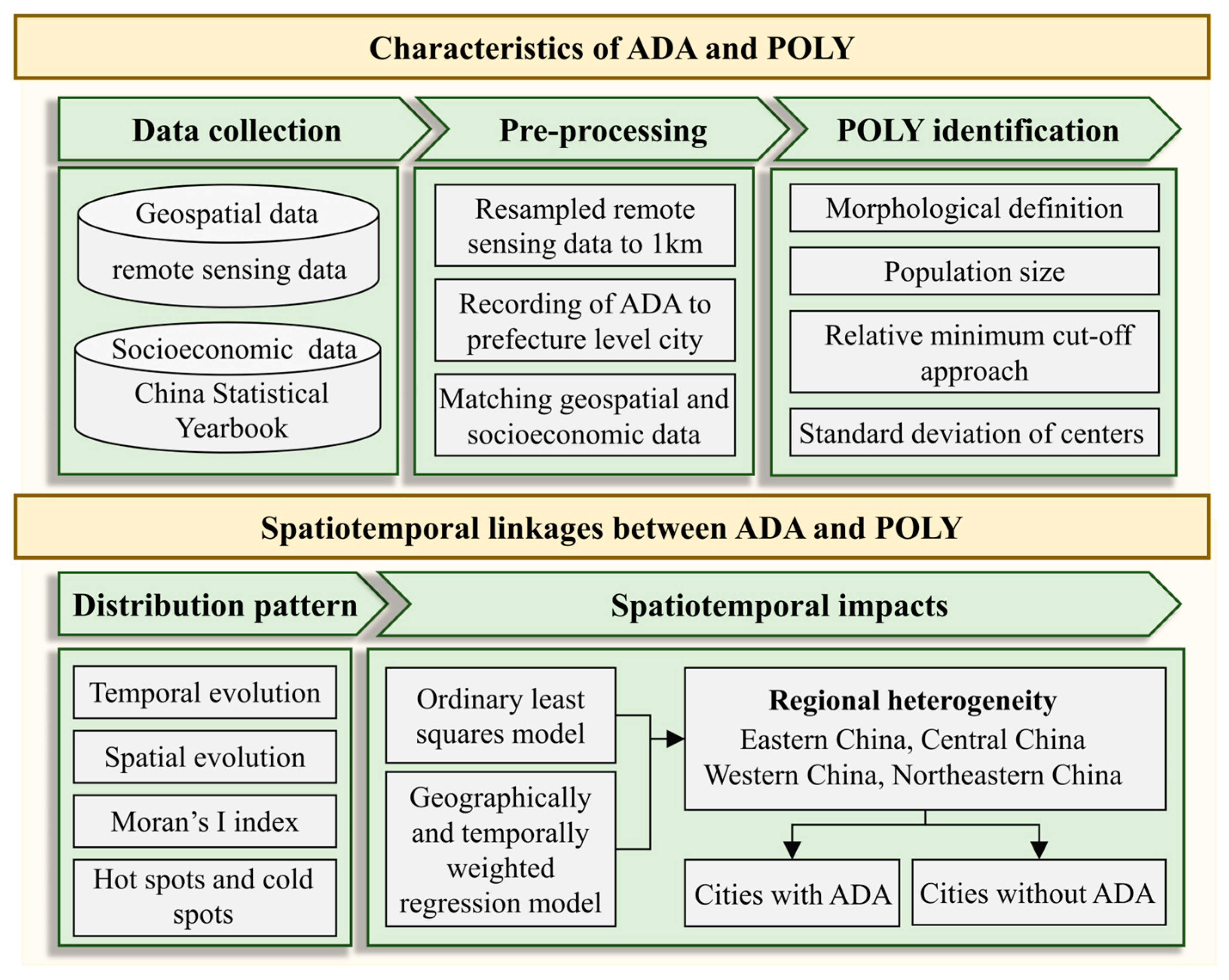
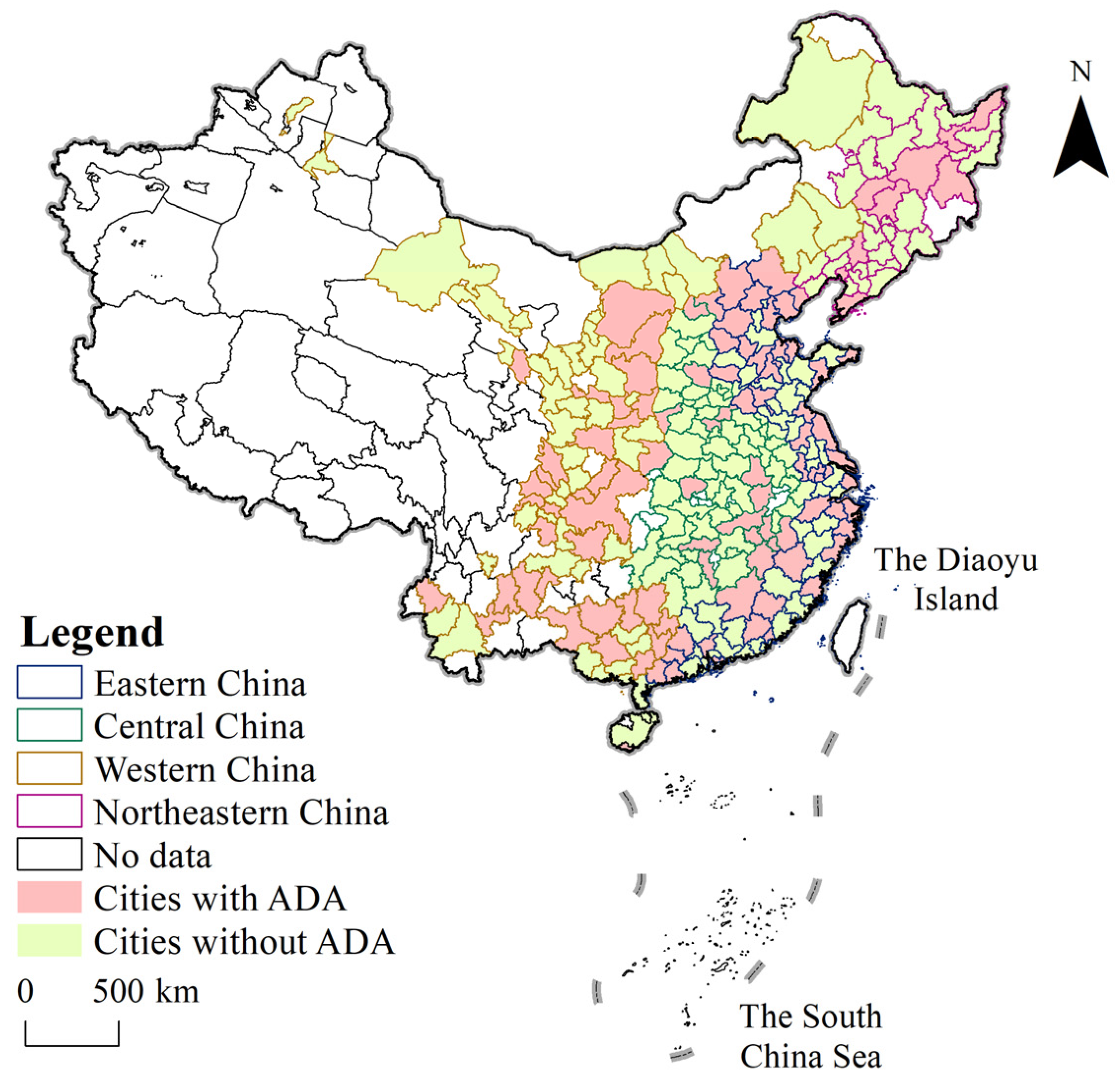
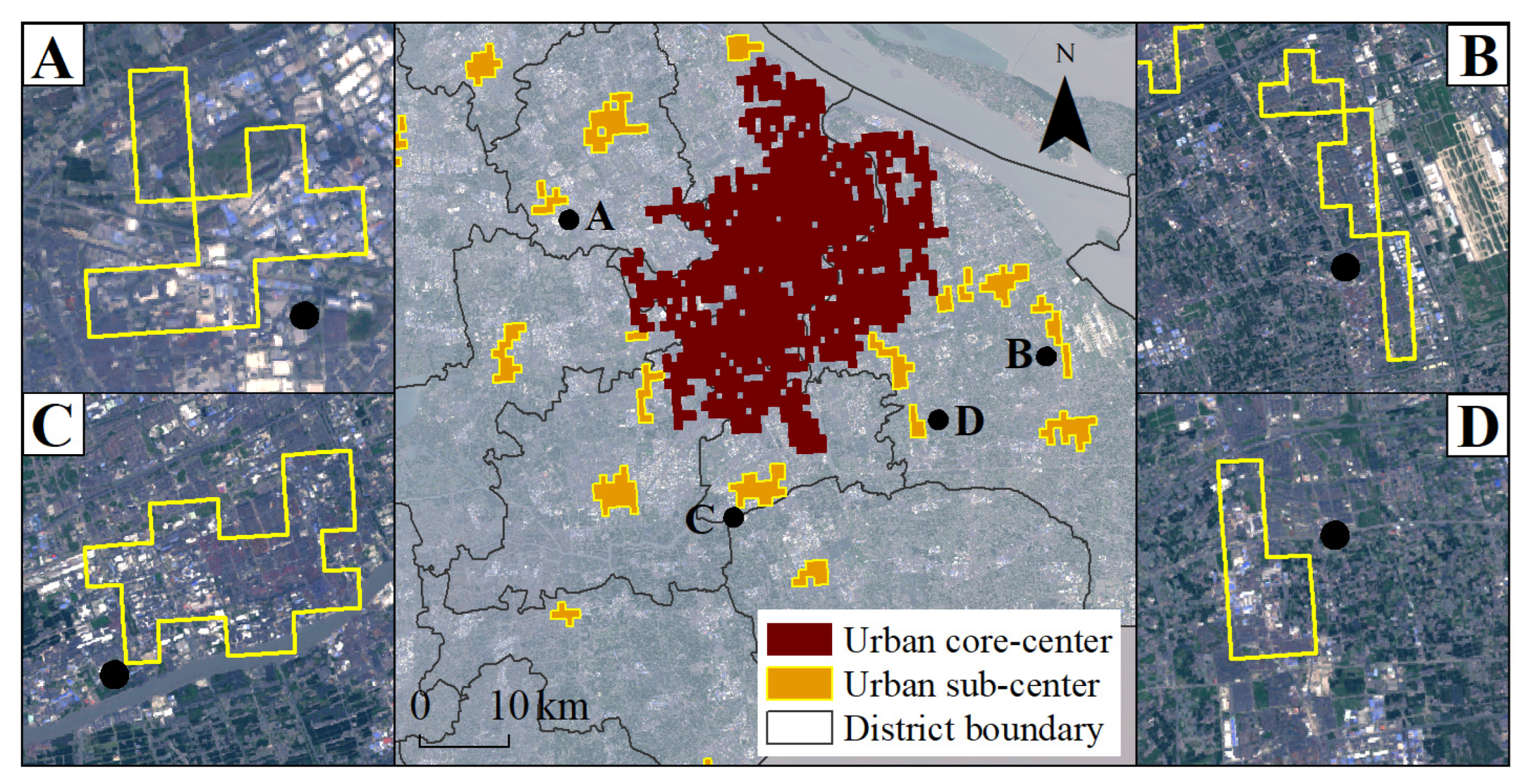
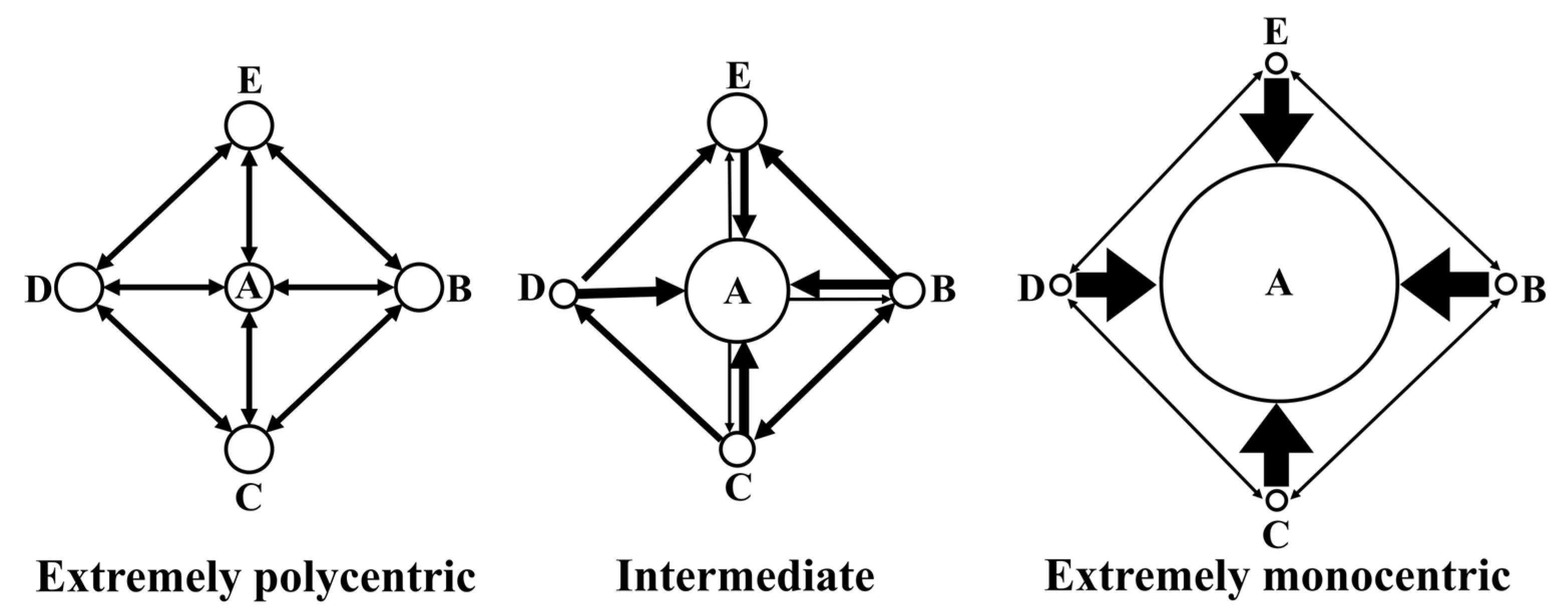


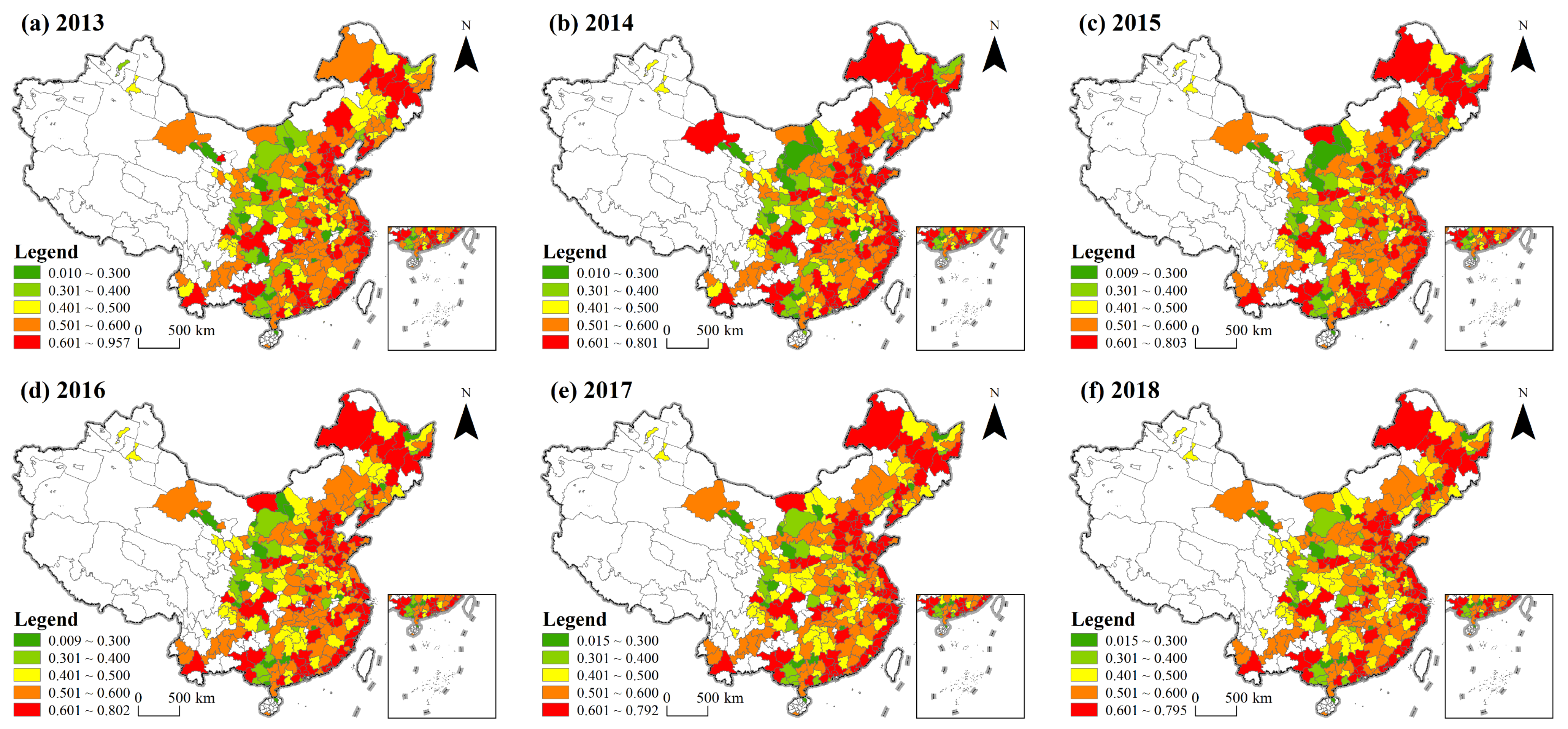

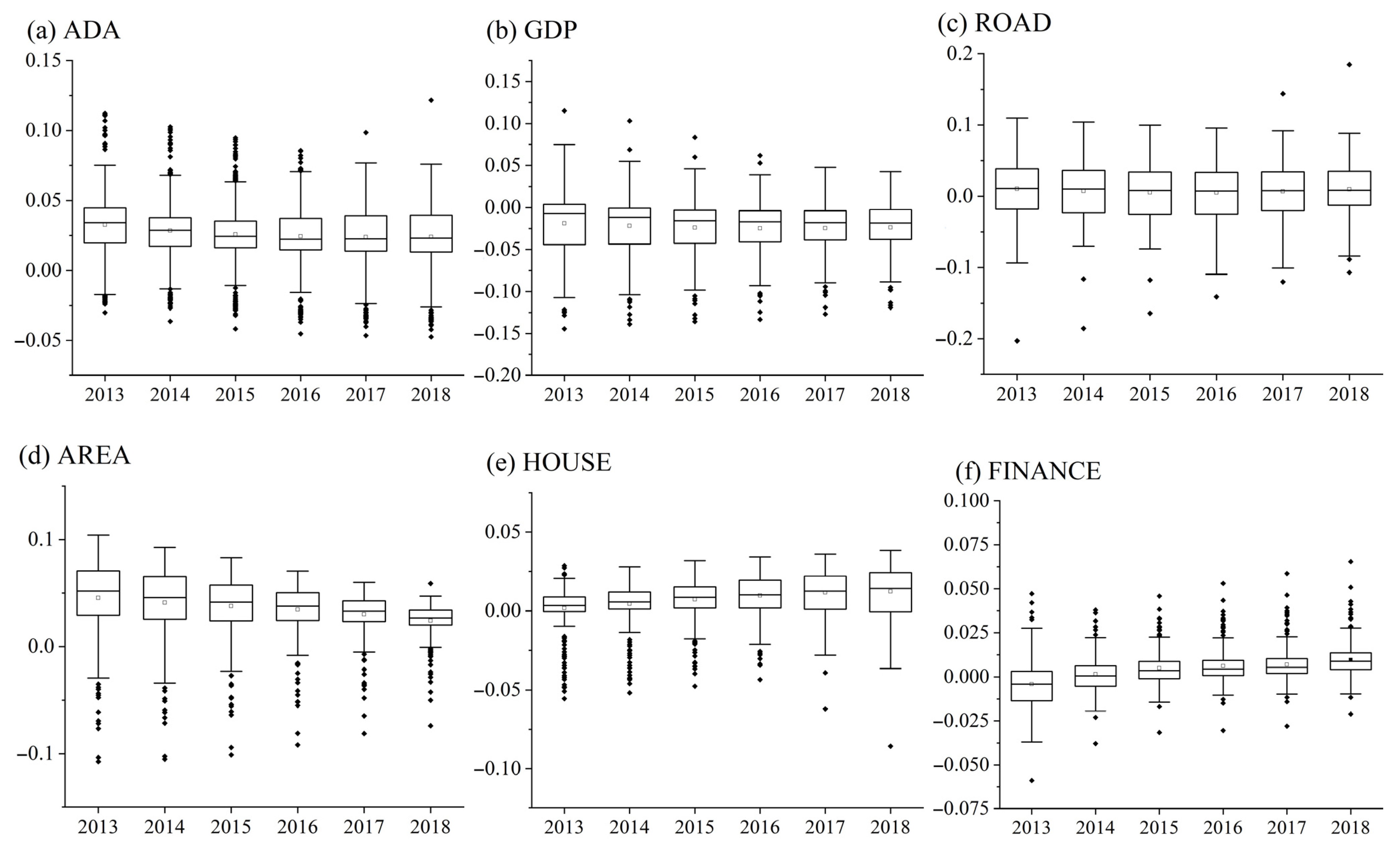
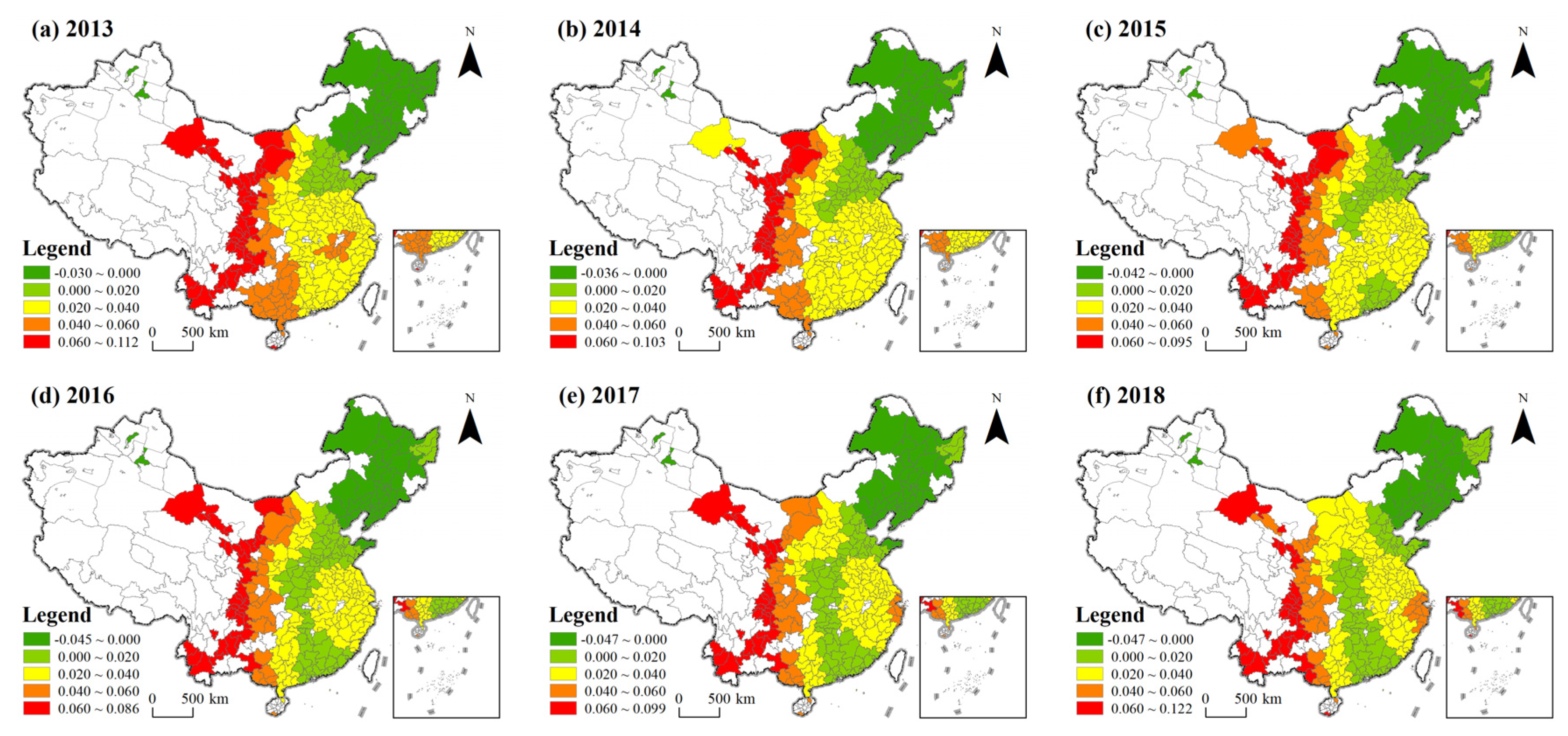
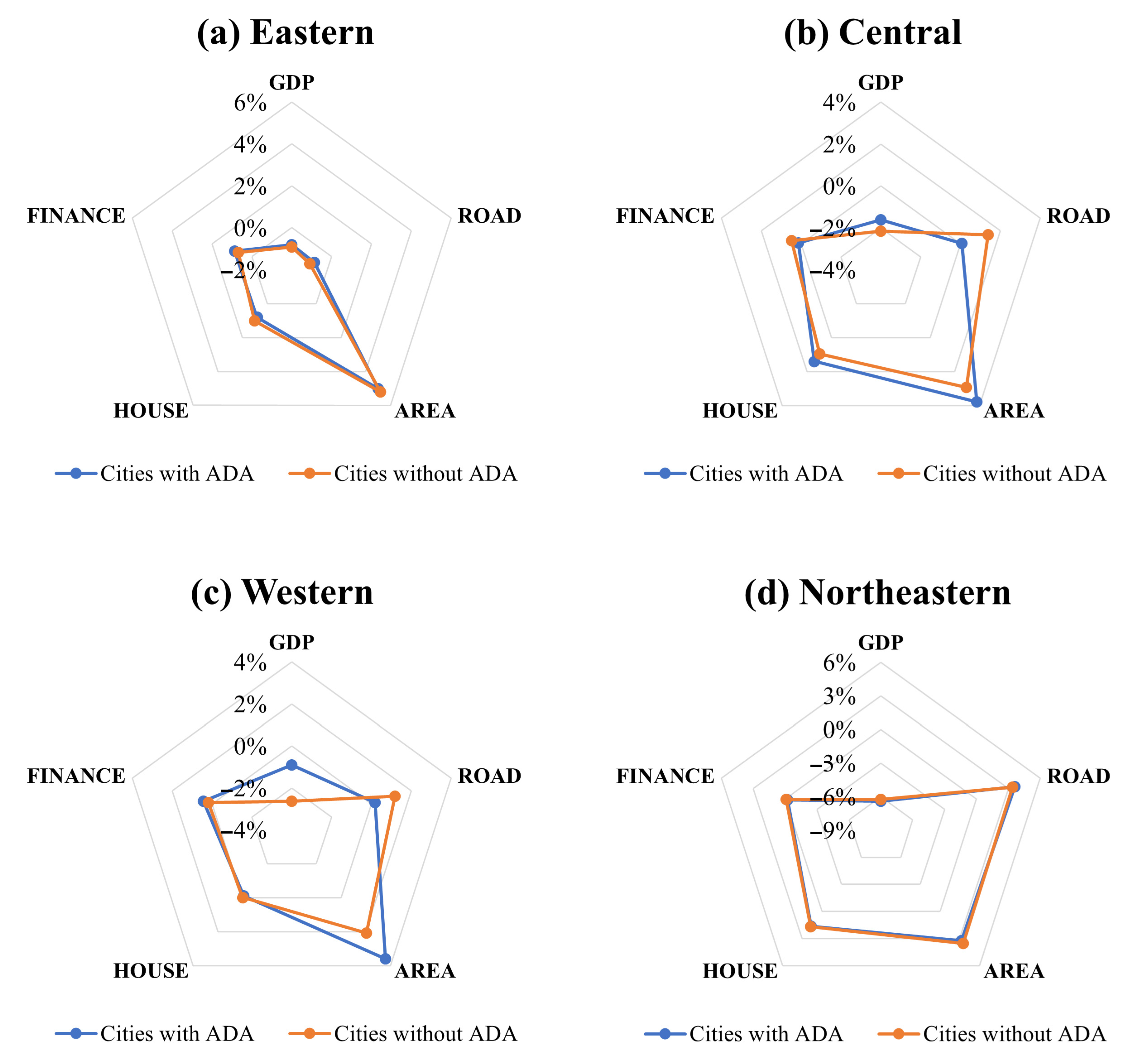
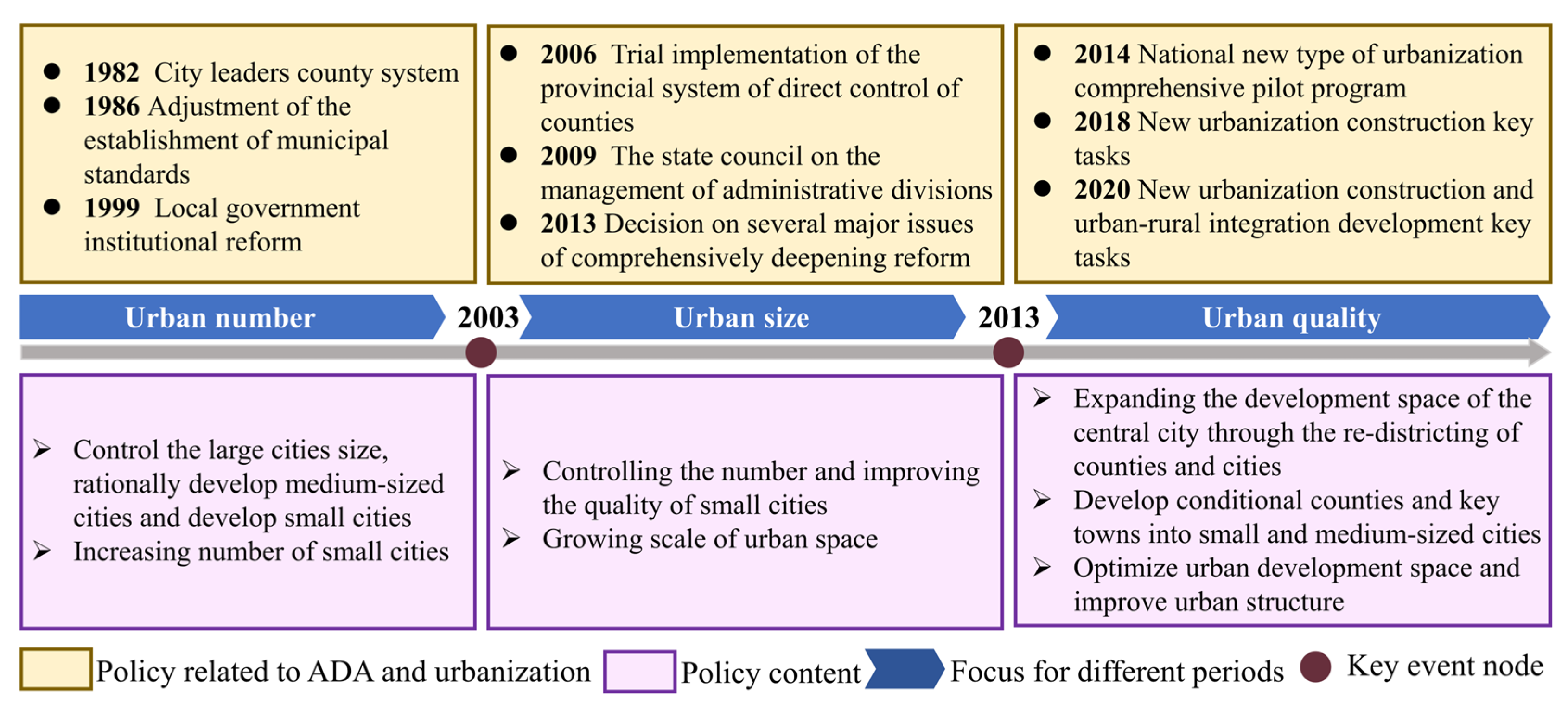
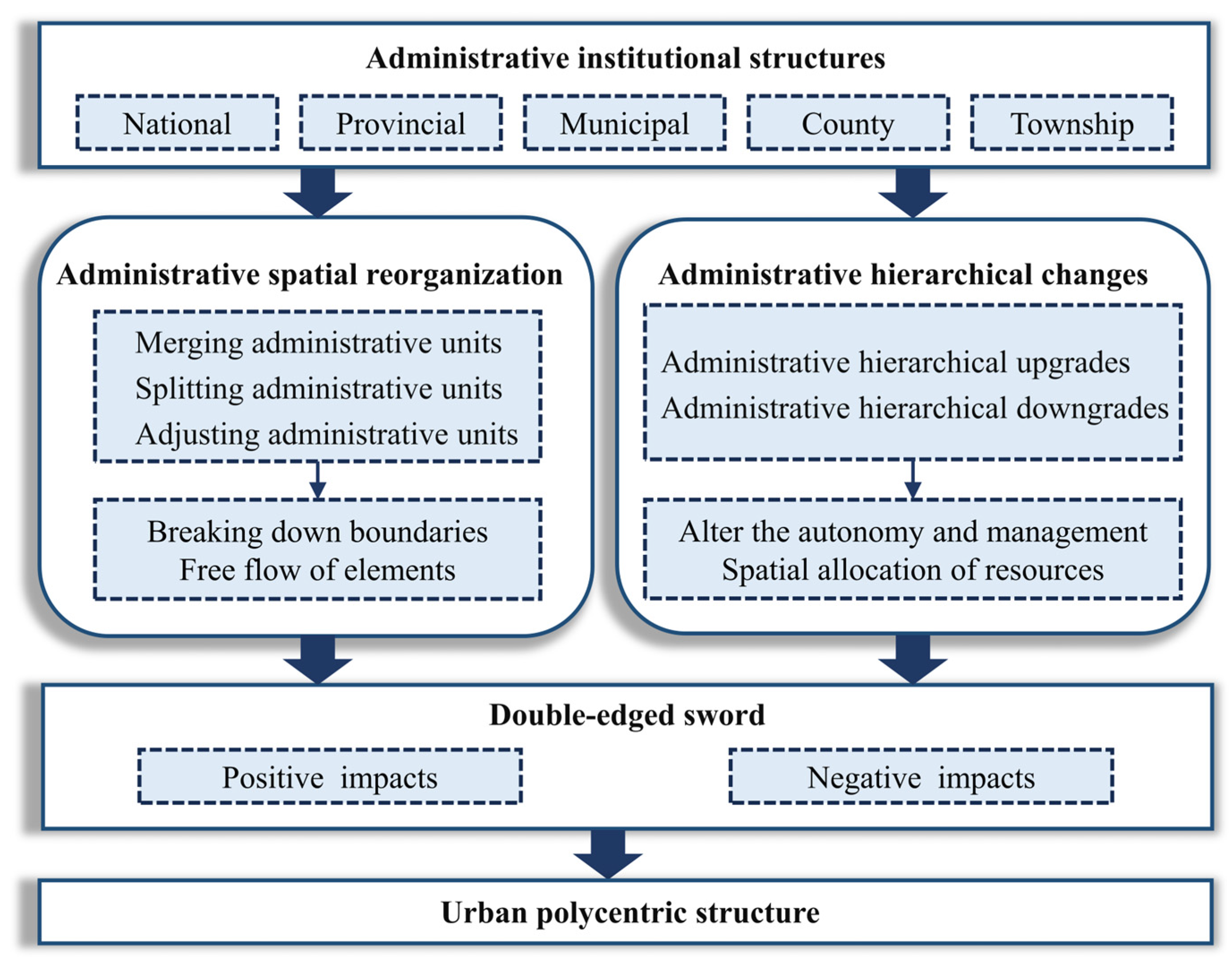
| Variables | Mean | Std. Dev | Min. | Max. |
|---|---|---|---|---|
| POLY (-) | 0.5199 | 0.1289 | 0.0093 | 0.9574 |
| ADA (-) | 0.2263 | 0.4185 | 0.0000 | 1.0000 |
| GDP (1010 CNY) | 0.0681 | 0.0373 | 0.0041 | 0.4393 |
| ROAD (102 km2) | 0.1364 | 0.0918 | 0.0117 | 1.0837 |
| AREA (104 km2) | 0.2707 | 0.3224 | 0.0097 | 4.3263 |
| HOUSE (1011 CNY) | 0.2739 | 0.5501 | 0.0007 | 4.2363 |
| FINANCE (108 CNY) | 0.0344 | 0.0685 | 0.0009 | 0.8351 |
| Year | Moran’s I | Mean | Standard Deviation | p Value |
|---|---|---|---|---|
| 2013 | 0.185 | −0.0020 | 0.0412 | 0.001 *** |
| 2014 | 0.231 | −0.0022 | 0.0408 | 0.001 *** |
| 2015 | 0.223 | −0.0022 | 0.0403 | 0.001 *** |
| 2016 | 0.223 | −0.0025 | 0.0406 | 0.001 *** |
| 2017 | 0.183 | −0.0022 | 0.0401 | 0.001 *** |
| 2018 | 0.182 | −0.0022 | 0.0403 | 0.001 *** |
| Variables | Coefficient | Standard Deviation | T Value | p Value |
|---|---|---|---|---|
| ADA | 0.0332 *** | 0.0073 | 4.53 | 0.000 |
| GDP | −0.0261 *** | 0.0066 | −3.92 | 0.000 |
| ROAD | 0.0155 ** | 0.0076 | 2.04 | 0.042 |
| AREA | 0.0233 *** | 0.0087 | 2.67 | 0.008 |
| HOUSE | 0.0096 ** | 0.0041 | 2.32 | 0.021 |
| FINANCE | 0.0071 * | 0.0043 | 1.66 | 0.096 |
| Constant | 0.3461 *** | 0.0697 | 4.97 | 0.000 |
| R2 | 0.1464 | |||
| Adjusted R2 | 0.1433 | |||
| RSS | 23.3284 | |||
| AICc | −2316.1072 | |||
| Variables | Mean | Max. | Median | Min. |
|---|---|---|---|---|
| ADA | 0.0265 | 0.1216 | 0.0260 | −0.0474 |
| GDP | −0.0231 | 0.1150 | −0.0155 | −0.1444 |
| ROAD | 0.0074 | 0.1846 | 0.0091 | −0.2030 |
| AREA | 0.0355 | 0.1041 | 0.0366 | −0.1075 |
| HOUSE | 0.0078 | 0.0384 | 0.0079 | −0.0856 |
| FINANCE | 0.0042 | 0.0654 | 0.0038 | −0.0589 |
| Constant | 0.3815 | 2.0224 | 0.3111 | −0.3468 |
| R2 | 0.3619 | |||
| Adjusted R2 | 0.3596 | |||
| RSS | 17.4498 | |||
| AICc | −2605.2158 | |||
Disclaimer/Publisher’s Note: The statements, opinions and data contained in all publications are solely those of the individual author(s) and contributor(s) and not of MDPI and/or the editor(s). MDPI and/or the editor(s) disclaim responsibility for any injury to people or property resulting from any ideas, methods, instructions or products referred to in the content. |
© 2023 by the authors. Licensee MDPI, Basel, Switzerland. This article is an open access article distributed under the terms and conditions of the Creative Commons Attribution (CC BY) license (https://creativecommons.org/licenses/by/4.0/).
Share and Cite
Chen, Y.; Wang, L.; Yu, P.; Nie, N.; Yang, X.; Chen, Y. Spatiotemporal Linkages between Administrative Division Adjustment and Urban Form: Political Drivers of the Urban Polycentric Structure. Land 2023, 12, 1674. https://doi.org/10.3390/land12091674
Chen Y, Wang L, Yu P, Nie N, Yang X, Chen Y. Spatiotemporal Linkages between Administrative Division Adjustment and Urban Form: Political Drivers of the Urban Polycentric Structure. Land. 2023; 12(9):1674. https://doi.org/10.3390/land12091674
Chicago/Turabian StyleChen, Youlin, Lei Wang, Peiheng Yu, Ning Nie, Xuan Yang, and Yiyun Chen. 2023. "Spatiotemporal Linkages between Administrative Division Adjustment and Urban Form: Political Drivers of the Urban Polycentric Structure" Land 12, no. 9: 1674. https://doi.org/10.3390/land12091674
APA StyleChen, Y., Wang, L., Yu, P., Nie, N., Yang, X., & Chen, Y. (2023). Spatiotemporal Linkages between Administrative Division Adjustment and Urban Form: Political Drivers of the Urban Polycentric Structure. Land, 12(9), 1674. https://doi.org/10.3390/land12091674








